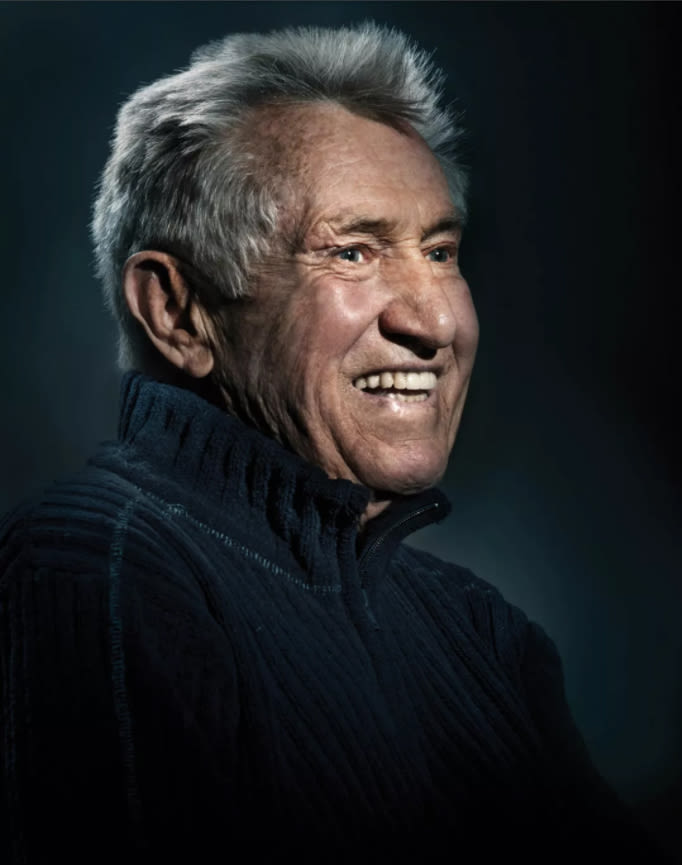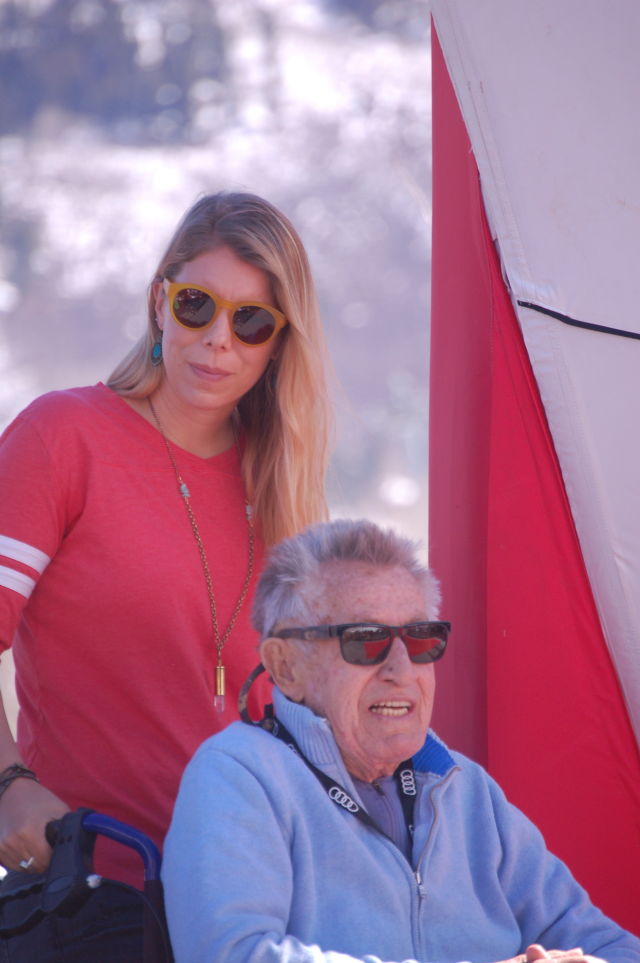A Conversation with Bob Beattie

Bob Beattie when he received one of our Sojourner Salutes honors in 2013
Image: Karl Wolfgang
This week, the Aspen Skiing Company released the much-anticipated Ski Town, Race Town: A Celebration of Ski Racing in Aspen—Roch Cup to World Cup Finals, a 240-page book that commemorates the storied history of racing on Aspen Mountain. In addition to relating Aspen's development as a US ski racing hub and showcasing numerous photos and recollections from last spring's World Cup Finals, the book features conversations with locals who played a key role in racing, both here and internationally. Among these transcripted chats is one between Skico Senior Vice President John Rigney and the one and only Bob Beattie, who died last Sunday, April 1, 2018, at the age of 85.
Former Aspen Sojourner editor Michael Miracle edited the book, along with Christin Cooper-Taché, who has some ski racing bona fides of her own: an Olympic silver medal in giant slalom and five World Cup wins. Find it at all Four Mountain Sports locations and the Aspen Shop (555 E Durant Ave). A launch party takes place this Thursday, April 5, at the Limelight Hotel from 5:30 to 7:30 p.m.
To celebrate the publication's release and honor Beattie's passing, we share this conversation from it:

Ski Town, Race Town: A Celebration of Ski Racing in Aspen—Roch Cup to World Cup Finals.
Bob Beattie was appointed the first full-time coach of the US Men’s Alpine Ski Team in 1961. At the 1964 Olympics in Innsbruck, his team won the first-ever medals for the US in men’s alpine skiing. Beattie helped found the World Cup ski racing series, as well as the World Pro Skiing Tour. As a ski-racing announcer, he called the famous Franz Klammer downhill win at Innsbruck in 1976. Beattie was an Aspenite since 1970.
John Rigney joined Aspen Skiing Company in 1989 as a ticket seller. Now he’s a senior vice president and is a driving force behind local event programming, including the X Games’ ongoing 18-year run in Aspen Snowmass. Rigney led the successful bid to host the 2017 World Cup Finals. He and his events team were charged with handling all of the finals’ finances, programming, and logistics, including coordinating a team of over 750 people.
John Rigney: Bob, you’re one of the creators of the World Cup. Remind us how it all started.
Bob Beattie: It was in 1966 with Serge Lang, a journalist from France, and Honoré Bonnet, who was the head coach of the French team. I said to Serge, “We’re never going to have what you want—races in multiple nations—without races in the US.” We had already started the American International Team Races, held in Vail in 1965. It was before the World Cup, but it was an important prelude. We invited three nations: France, the United States, and Germany. We didn’t invite any other country, so the United States would be no worse than third. That was the start. No races in the United States without including Americans.
Rigney: The conclusion of the World Cup’s 50th year happened right here in Aspen. Your affiliation with our town, and your love of sport, is so well known globally—to have you here playing an active role gave me and my colleagues tremendous pleasure.
Beattie: You know, having the finals here in Aspen, my hometown, a place I love, the best ski resort in the world, was so important to me. Little did I know it was going to be this big. I’ve been to millions of World Cup events, but never have I seen anything like the one here. This was the best World Cup I’ve ever been to.
Rigney: What made it so special?
Beattie: Easy—the people. Everybody came out of the woodwork. We never knew, you guys at the ski company and me, what it was going to be like. We couldn’t believe the numbers of people who got involved. People came from all over the country. It’s a very important thing, as far as US skiing is concerned. As we all know, ski racing in the United States and ski racing in Europe are quite different. In Europe, fans are hanging all over every racer.
Rigney: True. Here, it’s more casual. Plus, the mountain—the race venue—falls right into the town of Aspen. That connectivity is magical. If you had an aerial shot of any afternoon during the week, racers of the highest caliber were all over town doing a variety of things. Some were training, some were signing autographs. Some were going out for a bite to eat, and others were partying. But they were everywhere. I think that connectivity just adds to the magic.
Beattie: That’s very significant. When we started the World Pro Skiing Tour, dual racing, back in 1970, people would say, “That’s not going to work. They won’t come to the United States to race, the Europeans.” I never had to invite one single ski racer to join us. They came by themselves. They came to the United States because they like being here. They wanted to be a part of the scene. It’s a great atmosphere for athletes.
Rigney: I wanted the celebration to pour over from the grandstands into the streets, and down to Wagner Park. I wanted it to be about skiing, nightlife, music, art, culture. I wanted Aspen to show off all that it could show to the world in a one-week window. Remarkably, I think we did a pretty decent job of achieving that.
Beattie: It was even more of a home run considering that there were some people that didn’t want to have it happen—particularly Europeans.

Bob Beattie watches the World Cup Finals in Aspen in March 2017
Image: Cindy Hirschfeld
Rigney: We weren’t doing this to appease the F.I.S. or anyone else. We were doing this because Aspen’s a ski town. We’ve been involved in ski racing for several decades. We have some of the best courses and some of the richest history out there, and we know how to throw a party. We’re one of very few entities that really knows how to artfully blend the experience. It’s in our DNA.
Beattie: Yes—we go back. The Roch Cup has been famous forever. I coached the US Ski Team back in the ‘60s, and Aspen was our home base. We ate at a restaurant here in town—four dollars a day for all of our ski team.
Rigney: You’ve seen the full history of putting on World Cup ski races. What’s different from the beginning versus today?
Beattie: Well, as you could probably imagine, in the beginning it was catch as catch can. Now, it’s going through months and months of preparation. And a lot of money putting on these events.
Rigney: And there’s a lot of exposure as an organizer. You’re 100 percent at the risk of weather. If you don’t host a race due to too much snow or, in early season, too little snow, you stand to lose serious sums of money—the kind of sums that affect an entire organization. Then the rules can change even after you agree to host: prize money can increase, as can safety or lodging regulations; they change mandate infrastructure changes. We needed three different finish lines to accommodate the finals. You basically absorb the costs associated with any and all of those changes.
Beattie: And we had all four disciplines: downhill, slalom, giant slalom, and super G—plus the team event.
Rigney: One of the driving points behind our bid for this event was to bring the men back, as well as the speed events. Our history was built on the men coming here on a regular basis and on speed. The downhill, it’s got this mythical feel to it. Even people who had never been to a race came out, and they wanted to be at the bottom of the Airplane Turn. They wanted to see the pour over onto Aztec. The hype was amazing—and the races even more so.
Beattie: Speed events are the key to everything. We could talk about parallel racing, we could talk about everything else, but you know what? The speed events are what people pay attention to. Because at 80 miles an hour, skiers are risking their lives going down the mountain. Fortunately, the courses have been prepared much, much better than they used to be. Back in the Roch Cup days, it was, “Oh, boy. Away we go.” It was nowhere prepared like this. But the equipment is better now, and the courses are smoother, so you go faster.
Rigney: Bob, you also founded the World Pro Ski Tour and really pioneered the idea of head-to-head ski racing. It’s finally back in existence with the team event and will be at the Olympics next year.
Beattie: I’m surprised it took so long to get here, but I know why. It was originally a World Pro Skiing event, and the F.I.S didn’t want to do anything that made us look good. But the team event at the finals was exciting. I wanted bigger bumps, to be honest with you. And people turning in the air. Landing safely, but turning in the air. The course was too straight—bang, bang, bang, bang, bang.
Rigney: From a spectator perspective I like it because it’s just so easy to comprehend. There are nationalities involved, and each country has a very deep roster to choose athletes from. And it’s very visual. The whole race is over in 45 minutes, and you can always see who’s winning.
Beattie: I want to talk about the future. I don’t want Aspen to be left out, to be honest with you. I want Aspen on the World Cup race calendar every year. The World Cup Finals were a huge success. Everybody knows that. People who didn’t think the United States could do this were wrong. I’ve been fighting with the Europeans over the World Cup for many, many years, and I think that we need to stand up.
Rigney: Aspen gets consistent snowfall. We have excellent race crews, and we have the best ski town in the world that will come out and support racing of any variety. But this event in particular showed me that Aspen deserves more than what we’ve been doing on a regular basis. We love the women’s technical races in November, but the smiles, the pleasant surprises that came from the racers, their families, the support crews, and the federations by hosting the entire circuit was very powerful. Many of these folks grew up racing here. We touched something deep inside those folks, and I have a feeling Aspen’s place on the calendar will work itself out.













































